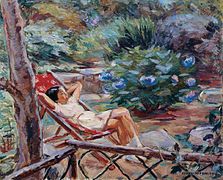Minami Kunzō
Minami Kunzō ( Japanese 南 薫 造 ; born July 21, 1883 in Uchi-no-umi ( 内海 ), today Kure district , Hiroshima Prefecture ; died January 6, 1950 ) was a Japanese painter in the "Western style" ( Yōga ) during the Meiji , Taishō and early Shōwa periods . Kunzō is also known for his watercolors and woodcuts.
life and work
Minami Kunzō attended from 1902 the department for western painting of the art college Tōkyō (today Geidai ), where he studied under Okada Saburōsuke and graduated in 1907. During this time he learned to play the mandolin together with the painter Hirai Takeo ( 平井 武雄 ) and others under Tomimoto Kenkichi . Kunzō kept in touch with fellow students and other friends throughout his life.
Immediately after completing his training in 1907, Kunzō went to Europe for ten years. He studied in England for two years under Borrow-Johnson , then went to Paris until January 1910. During this time he also visited Germany, Italy and the Netherlands and came into contact with a wide range of European painting and culture. Kunzō also came together with the artists Takamura Kōtarō , Shirataki Ikunosuke ( 白 瀧 幾 之 助 ; 1873-1960) and Arishima Ikuma . He also often met Tomimoto, who was in London, there.
After Kunzō's return, the artist community "Hakuba-kai" ( 白馬 会 ) organized an exhibition with works from his time in Europe under the direction of Arishima. Arishima won him over for the magazine for contemporary art and literature " Shirakaba ", where he was responsible for the design of the cover.
With its light and warm color scheme, it won a second prize four times from the colorful one. After 1916 he became a jury member at both the Bunter and the successor organization Tei-ten. Minami also exhibited at the Society for Watercolor Painting's annual exhibition. In 1918 he became a member of the Kofu-kai ( 光 風 会 ). In 1939 he became a member of the Imperial Academy of Arts , in 1932 he was appointed professor at the Tōkyō School of Art and in 1944 Teishitsu gigei-in .
Kunzō traveled extensively in Japan to make sketches and watercolors of landscapes. In May 1925 he traveled to Korea with the painter Tsuji Hisashi ( 辻 永 ; 1884–1974).
His typical images include "A day in June" ( 六月 の 日 Rokugatsu no hi ), "Grape trellis" ( 葡萄 棚 Budō-dana ), "Cranes passing by" ( 鶴 渡 る Wataru tsuru ) and "Morning by the water" ( 水 辺 朝 Mizube no asa ).
His students include Ogi Tarō ( 荻 太郎 ; 1910–2009), Watanabe Takeo ( 渡 辺 武夫 ; 1919–2003), Nomiyama Kyōji ( 野 見 山 暁 治 ; * 1920), Niinobe Teruo ( 新 延 輝 雄 ; 1922–2012) and others .
photos
Port of Kure , 1926
Remarks
- ↑ Bun-ten ( 文 展 ) is the abbreviation for "Mombushō bijutsu tenrankai" ( 文部省 美術展 覧 会 ), the annual art exhibition organized by the Ministry of Culture from 1907, which is then known as "Teikoku bijutsu tenrankai" ( 帝国 美術 院 展 覧 会 新 ), abbreviated as parting ( 帝 展 ). Today “Nihon bijutsu tenrankai”.
- ↑ An award for artists who were under the special protection of the emperor, which was introduced in 1890 and now no longer exists in this form.
literature
- Suzuki, Toshihiko (Ed.): Minami Kunzō . In: Nihon daihyakka zensho (Denshibukku-han) . Shogakukan, 1996.
- Laurance P. Roberts: Minami Kunzō . In: A Dictionary of Japanese Artists . Weatherhill, 1976. ISBN 0-8348-0113-2 .
Web links
Individual evidence
- ↑ In the documents on Minami Kunzō des Bunka-chō , ボ ロ ー ・ ジ ョ ン ソ ン Borō Jonson is given as the teacher . It has not yet been verified.
| personal data | |
|---|---|
| SURNAME | Minami, Kunzō |
| ALTERNATIVE NAMES | 南 薫 造 (Japanese); Minami, Kun (real name); 鈼 太郎 (real name, Japanese) |
| BRIEF DESCRIPTION | Japanese painter |
| DATE OF BIRTH | July 21, 1883 |
| PLACE OF BIRTH | Cure |
| DATE OF DEATH | January 6, 1950 |





